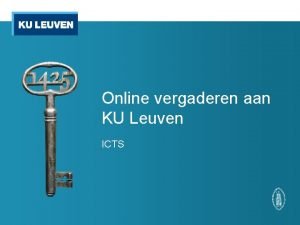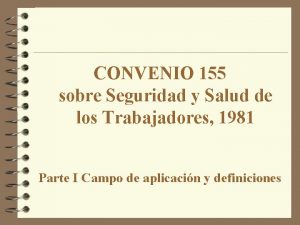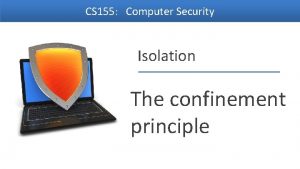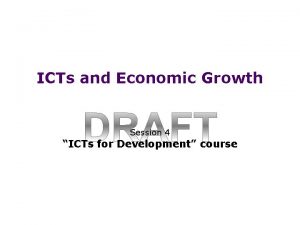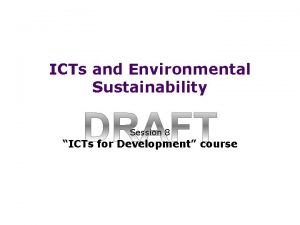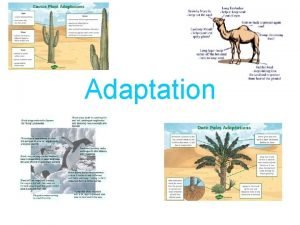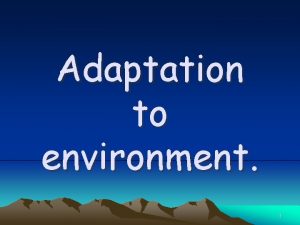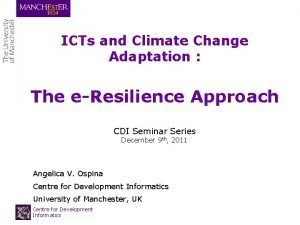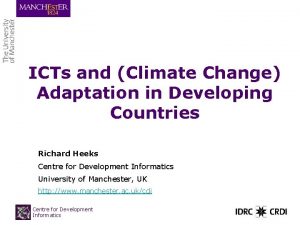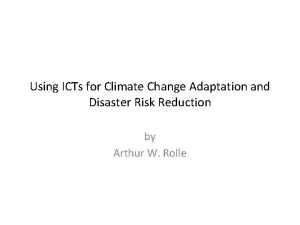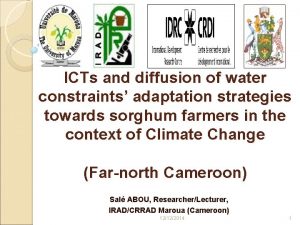Overview of Question 155 ICTs and adaptation to














- Slides: 14

Overview of Question 15/5 “ICTs and adaptation to the effects of climate change” Nevine Tewfik Egypt Rapporteur of Question 15, ITU-T Study Group 5 Committed to connecting the world

Working Party 3 (WP 3/5) ICT and climate change Work areas: § Q 13/5 - Environmental impact reduction including e-waste § Q 14/5 - Setting up a low cost sustainable telecommunication infrastructure for rural communications in developing countries § Q 15/5 - ICTs and adaptation to the effects of climate change § Q 16/5 - Leveraging and enhancing the ICT Environmental sustainability § Q 17/5 - Energy efficiency for the ICT sector and harmonization of environmental standards § Q 18/5 - Methodologies for the assessment of environmental impact of ICT § Q 19/5 - Power feeding systems Committed to connecting the world

Question 15/5 ICTs and adaptation to the effects of climate change Main study area: § Studying how ICTs can be effective in enabling countries to better adapt to climate change; § Studying how the telecommunications infrastructure and associated ICT can be resilient to the effects of climate change; § Producing Recommendations; § Collecting, sharing and disseminating information and best practices. Committed to connecting the world

Question 15/5 ICTs and adaptation to the effects of climate change Main Tasks: § Establishing requirements via questionnaires and analysis; § Seeking cooperation with various expert groups and Task forces; § Encouraging the sharing of use cases in ICT and climate change; § Encouraging ICT industry involvement in climate change adaptation. Committed to connecting the world

Deliverables under study § Draft Recommendation ITU-T L. Cities_Adaptation - how ICTs can help cities to adapt to the effects of climate change § Draft Recommendation ITU-T L. Infrastructure_Adaptation - best practices for the adaptation of the ICT infrastructure to the impacts of climate change § Draft Supplement to ITU-T L. 1500 series on effects and possible impact of climate change Contributions are needed! Committed to connecting the world

Highlights on deliverables § New Recommendation ITU-T L. 1500 - Framework for information and communication technologies (ICTs) and adaptation to the effects of climate change (consented) Ø Recommendation ITU-T L. 1501 - on how countries can utilize ICTs to adapt to the effects of climate change (consented) Ø Recommendation ITU-T L. Infrastructure_Adaptation - on adapting the ICT infrastructure to the effects of climate change (under development) Ø Recommendation ITU-T L. Cities_Adaptation - on how ICTs can help cities to adapt to the effects of climate change (under development) Committed to connecting the world

Highlights on deliverables Recommendation ITU-T L. 1501 Best practices on how countries can utilize ICTs to adapt to the effects of climate change The role of ICTs in adaptation to climate change § ICT can provide the basic access to information, capital and resources which can improve economic development and reduce vulnerabilities § ICTs can be used for each of the following steps § § § Observation (combining existing data in new ways) Analysis and planning Implementation and management Capacity building Networking Monitoring and evaluation Committed to connecting the world

Highlights on deliverables Recommendation ITU-T L. 1501 Best practices on how countries can utilize ICTs to adapt to the effects of climate change Framework for ICTs and climate change adaptation § ITU-T L. 1501 provides the multi-level framework for ICTs integration in Climate Change adaptation for countries to integrate ICTs into their national climate change adaptation strategies § Three main components of the framework: § Content: policy development § Structure: institutional arrangements § Design and implementation of coherent Process Committed to connecting the world

Highlights on deliverables Recommendation ITU-T L. 1501 Best practices on how countries can utilize ICTs to adapt to the effects of climate change Checklist of Indicators § To assist countries ensure that they meet the necessary requirements for the adoption and the implementation of the framework for ICTs and climate change adaptation § To assist countries ensure that they keep a record of the possible trends linked to climate change Committed to connecting the world

Resilient Pathways: The Adaptation of the ICT Sector to Climate Change Authors: Ospina, A. V. , Faulkner, D. , Dickerson, K. , Bueti, C. Objective of the report: § To explore the impacts of climate change on the ICT sector and the potential for adaptation, while emphasizing the need for resilient pathways of action, enabling environments and new standards. Committed to connecting the world

Resilient Pathways: The Adaptation of the ICT Sector to Climate Change Resilience: A relevant concept An innovative approach: Ability of the ICT sector to withstand, recover, adapt, and potentially transform in the face of climate change impacts. A changing climate will lead to a changing business environment. Ospina and Heeks (2010) Recognizing the problem, identifying the risks, and responding with adaptation measures can help businesses minimize their risks and build resilience [to projected and unanticipated change]. Partnership for Resilience and Environmental Preparedness (PREP) Committed to connecting the world

Resilient Pathways: The Adaptation of the ICT Sector to Climate Change Resilient Pathways Framework CLIMATE CHANGE Extreme events (short term) + Chronic trends (long term) ICT Sector Adaptation IMPACTS ADAPTIVE ACTIONS Levels: International National Sectoral Local Resilience Attributes: Robustness, self-organization, learning, scale, rapidity, redundancy, flexibility and diversity Committed to connecting the world

Resilient Pathways: The Adaptation of the ICT Sector to Climate Change Conclusions: § Adaptive practices: part of the “new normal” for business operations § Adaptive approaches: assessment of the potential risks and vulnerabilities, direct and indirect impacts of climate change, as well as mechanisms to tackle new business opportunities and new standards. § Adoption of resilient pathways: by going beyond generic contingency and risk management measures. Integrating the attributes of resilience can help strengthen the sector’s approach to climate change adaptation by improving its ability to cope, adjust and potentially transform, and by enabling sector-wide strategies in the face of short-term shocks and long-term trends. Committed to connecting the world

Additional information § ITU-T/SG 5 “Environment & Climate Change” itu. int/go/tsg 5 § ITU-T and Climate Change itu. int/go/ITU-T/climate THANK YOU! tsbsg 5@itu. int Committed to connecting the world

